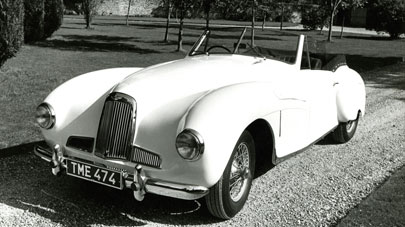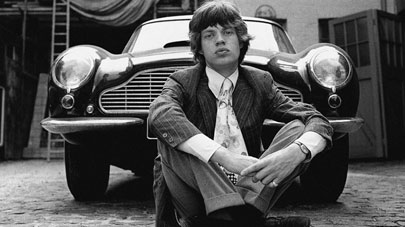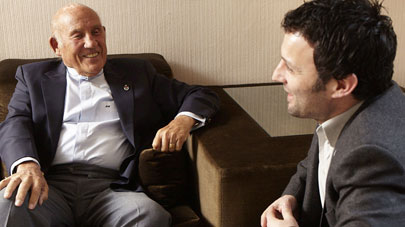Previous Article
Next Article
- AM WORLD
- 100 YEARS OF ASTON MARTIN
Centenary Design
ON THE RIGHT LINES
The iconic and unforgettable looks of Aston Martin models through the years have often reflected the influences and trends from the wider world of architecture and design, writes Jonathan Glancey
Slide image »
A 1930s sheer lamé dress by French fabric designer Madeleine Vionnet, whose body-hugging lines are echoed in the sleek bodywork of the finest Aston Martins.
The Aston Martin DB1, launched in 1948, was the first product sold under David Brown’s ownership. He moved the company into the world of fast, luxurious grand touring cars that would epitomise the marque.
A sked to imagine his ideal car, Lionel Martin said he dreamed of a machine that combined the virtues of a Bugatti and a Rolls-Royce. The very first Aston Martin was a brisk road and competition car—neither as glamorous as a Bugatti, nor as luxurious as a Rolls-Royce. What it was, though, was a marriage of British and Italian engineering, powered by a 1.4-litre Coventry Simplex engine cradled in the chassis of a 1908 Isotta-Fraschini racer. The hunched-up bodywork of the second prototype of 1915 gave this otherwise nimble car its decidedly inelegant nickname, the “Coal Scuttle”.
Yet from then on, these meticulously engineered and highly successful cars developed a character that has been handed down and developed from generation to generation—from the “Coal Scuttle”, through the superb Bertelli Aston Martins of the 1920s and 1930s, the glorious DB grand tourers of the 1950s and 1960s, to today’s muscular and voluptuous cars. This character has been, both determinedly British and international, underpinned by a very special relationship between the engineers and stylists of Italy and Great Britain. And, in the greatest of its designs, Aston Martin has indeed created cars that combine the qualities of Bugatti and Rolls-Royce. If Aston Martin’s Italian connection was at its most brilliantly clear during the David Brown era, it had been there, in fact, from the beginning.
“The DBR1 had the lines and haunches of a racehorse, stretched in aluminium over a space-frame chassis”
Bamford and Martin had produced just 54 cars before the company was re-founded in 1926 under the direction of “Bill” Renwick and Augustus “Bert” Bertelli. The cars manufactured from 1926 have always been known as Bertelli Aston Martins. In the brilliant series of 1.5-litre cars, beginning with the International of 1929, and working through the Le Mans model of 1932 to the pugnacious 100mph Ulster of 1934, Renwick and the Bertellis gave shape to machines that remain, even today, an utter delight to drive whether on the public road or track. Lithe, taut and minimally elegant, these are beautifully machined tools. They were, of course, for the most part, hand-crafted, as were the finest aircraft of the time. Like contemporary Hawker, Supermarine and Macchi fighters and racing airplanes, they enjoyed a beauty derived from a highly defined sense of purpose. Perhaps it’s no surprise that during the First World War, Aston Martin’s machine tools were sold to the Sopwith Aviation Company.
Bertelli Aston Martins may not be as beautiful as the very best Bugattis—nor, with their firm ride, nothing like as comfortable as contemporary Rolls-Royces were—yet they are lovely and highly distinctive things to look at with their angled radiators set back over aprons covering filler-capped oil-tanks, their louvred bonnets, sharply defined mudguards and gleaming external exhaust pipes. Inside, crisp arrays of dials are matched by stubby, short-throw, rifle-bolt-sure gearshifts and a sense of indestructability (many survive, and race flat-out, today).
The Italian connection was reinforced, and indeed perfected, after the Second World War. Now owned by David Brown, Aston Martin moved into the world of fast, luxurious grand touring cars that it would make synonymous with its name. At the same time, Brown nursed the company back into racing—the DBR1, lithe yet voluptuous, had the lines and haunches of a racehorse, stretched in aluminium across a space-frame chassis and conjured by Ted Cutting, who had joined the company from Allard in 1946.
Aston Martin began building the DBR1 in 1956, its distinctive triangular vent on the side becoming a standard design touch in future models. The supple and muscled lines of the DB4 reflected a love of racehorses, like Irish thoroughbred Arkle, winner of three Cheltenham Gold Cups.
The new generation of road cars was developed over the course of a decade. The spirit of the pre-war Bertelli machines was retained in the no-frills, aircraft style cabins of the DB grand tourers, as was their firm ride, precise steering and freedom from frills and extraneous detailing. As American car designers, and their copy-cat European counterparts, exhibited a new-found love of fins, chrome and jukebox styling, Aston Martin went its own way and, finally, with the DB4 of 1958, produced a true design classic, a car of almost peerless beauty, highly resolved, all-of-a-piece and hugely seductive. Of course, there were competitors in the guise of fast, deluxe machines from Ferrari, Maserati and Facel Vega, if not yet from Jaguar, yet the DB4 was very special: a deeply satisfying coupling of British engineering and Italian styling.
In the lines of this immensely capable 140mph grand tourer, launched at the 1958 Paris Salon, Federico Formenti of the Milanese coachbuilder Carrozzeria Touring drew together the functional, sensual, tactile and even mythical elements that made a David Brown Aston Martin as much an emotion as a machine. I fell in love with the DB4 as soon as I could recognise the car as little more than a toddler in the 1960s. How I cherished my Corgi DB4s. And how, many years later, the real car refused to disappoint. The more powerful, short-chassis DB4 GT that followed is even more desirable, while the Zagato-bodied DB4 racer is as sensational to look at, and to listen to, today as it was when unveiled at the 1960 Earls Court Motor Show.
If the lines of the DB4 are compelling, so, too is what underpins them. Formenti’s bodywork—a fine aluminium cloth or skin—is stretched tightly around Touring’s patented Superleggera (“super light”) tubular steel skeleton. The way this expressive, sleek and curvaceous metal “fabric” suggests sensuality as well as elegant and captivating motion reminds me of the glamorous, and very sexy, bias-cut 1920s dresses by Madeleine Vionnet, the innovative French fabric designer, often described as an “architect among dressmakers”. The way bias-cut dresses cling to the body while moving with the wearer is akin to the bodywork of the finest Aston Martins: cars, if you like, as couture.
Beneath the long bonnet of the DB4 is another form of beauty, this time strictly mechanical: a strong, musical and sculptural 3.7-litre, twin overhead-cam, “straight six” engine designed by “Tadek” Marek, a Pole settled in England. The chassis is the work of Aston Martin’s Harold Beach, the gearbox by David Brown. These elements went—and go—together to shape and to breathe life into the car that continues to set the benchmark for Aston Martin design. The very latest DB9 is, without question, a direct descendant of the DB4. Car designers like to talk about the “DNA” of a particular marque or model, and given the apparent consistency of the bounding line that can be drawn from the DB4 to the DB9, their use of this scientific term is understandable.
The Aston Martin team at Feltham, Middlesex, meanwhile, had been working hard towards the DB4. Don Hayter, who, as an engineering apprentice had worked on design details of Lancaster bombers and Spitfires during the Second World War and went on to style the evergreen and perennially popular MGB, had shaped the DB2/4 and worked on the prototype DB4. He maintained a close relationship with Carrozzeria Touring and helped to ensure that this magnificent car was just the right blend of British reticence and Italian exuberance. If not by deliberate design, then by association, this landmark Aston Martin, together with many ensuing models, was also a reflection of wider design currents abroad at the time, in Britain and Italy, if not in the United States.
Its curved lines, supple and neatly muscled, reflected a love of racehorses (Ferrari’s badge was, of course, a prancing horse), but also of supremely fast machines such as the RAF’s beautiful Hawker Hunter (a jet-age Spitfire), of the celebrated curvaceous torsos of the latest Italian starlets—Gina Lollobrigida, seen in posters in a bikini astride the curved rump of a Vespa motor scooter, and Stefania Sandrelli, pouting leggily in a stable with a Vespa. There were even echoes of high-speed Italian trains like the eye-catching ETR 300 Settebello (Seven of Diamonds). These rounded, streamlined 180kph electric expresses, put into service from 1952 from Milan to Rome, had design input, inside and out, from the Italian architects Giulio Minoletti and Gio Ponti.
Beneath those curves, the very construction of the DB4 reflected some of the latest currents in architecture and engineering design. While Touring was working on the DB4 in Milan, Gio Ponti was designing the thrilling Pirelli Tower in the same city. Ponti provided the outline of this graceful, curving, catwalk-model slim skyscraper, while the brilliant Italian structural engineer, Pier Luigi Nervi, fashioned its “superleggera” concrete skeleton.
For all its sensual curves and lightweight frame, the DB4 is also a very masculine car, a gentleman pugilist in a bespoke Italian suit (by Hardy Amies, perhaps, circa 1960). Small wonder the DB5 was chosen as a mechanical steed for the cinema’s James Bond. It is this brilliantly embodied sense of energy and purpose, this feeling that the DB4 is a part of the spirit, or genius, of its times (at their very best), and downright “sex appeal”, that makes the DB4 one of the greatest of all cars. There were rivals, of course, especially from Italy, but the DB4 was only bettered by the DB4 GT and the howling and brawny, bulldog-beautiful DB4 GT Zagato styled by the 23-year-old Ercole Spada.
Aston Martin brought its own distinctive style to the new-found love for fins and chrome with the DB4. Italian style, such as the shapely presence of Gina Lollobrigida, seen on a Vespa in 1952, was pervasive and influential
The influence of Italian engineering could also be seen at the time in the design of such everyday 1950s exotica as espresso machines in British coffee bars (Gio Ponti designed a wildly curvaceous espresso machine for La Pavoni). And, far less likely, perhaps, in the design of the very last express passenger mainline steam locomotive for British Railways.
Built in 1954, 71000 Duke of Gloucester exhibited the muscular, slightly hunched and elegant lines of a David Brown Aston Martin. Designed by a BR team led by Frederick Harrison, who had worked on Nigel Gresley’s world-record breaking Mallard in the mid-1930s, Duke of Gloucester was a fine-looking steam locomotive that proved to be among the most efficient of her breed. Key to its exceptionally low fuel consumption was its rotary-cam poppet valve gear, originally designed by Arturo Caprotti, an Italian engineer who had been head of the design office for Cars Florentia, a Florentine company that produced a number of fine cars between 1901 and 1910.
While there is a clear design legacy stretching from the DB4 to the DB9 and, at a stretch, from the very first Aston Martin to today’s continent-crossing grand tourers, there was a brief period when Aston Martin design took a new direction. This was the fascinating and still controversial work of William Towns whose first design was the wide, low, crisp and striking DBS of 1967. The DBS, however, was only an inkling of what Towns had in mind. His masterstroke was the other worldly Aston Martin Lagonda of 1976. Here was a paper-dart of a car, an improbably long wedge of aluminium sheeting that looked like nothing else on the road. Its extraordinary styling was matched by such novelties as digital instruments glowing—but not always, much to the concern of bewildered drivers—from a massive slab of dashboard. The car held great appeal to buyers in the Middle East, but it has taken decades for its star to rise in Britain.
The Lagonda was a shock to Aston Martin customers, some of whom, it was thought, might like a four-door grand tourer as families grew or as modern-minded VIPs needed ferrying from some hi-tech-style headquarters to a private jet. And yet, the very architects responsible for such hi-tech-style buildings would have been among those least surprised by the new Lagonda. Why? Because the wedge or ski-slope school of design had been developing apace since the start of the decade, and notably in Italy. Fashionable architects, designers and their clients were familiar with such essential wedge-shaped office gadgets as the Olivetti Logos calculator of 1972, and even the Yamaha TC-800 Tape Deck of 1975.
Both these sleek designs were by the Milanese architect Mario Bellini, who pushed the limits of the Seventies “wedge” with the Olivetti ETP55 electronic typewriter that first appeared in 1987, shortly before production of the Towns’ Lagonda ended. The “wedge” was a brief episode in Aston Martin’s century’s-old design history, and yet it is fascinating to learn that even this curiously aberrant aesthetic had been developed hand-in-hand with Italian industrial designers and architects.
William Towns’s controversial 1976 Aston Martin Lagonda and Mario Bellini’s Olivetti ETP55 typewriter.
Lagonda itself played an intriguing role in Aston Martin’s international design story. The company was founded in Staines, Middlesex, in 1906 by Wilbur A Gunn, an aspiring US opera singer who had settled in England in the late 1890s. After a buy-out in 1935, new management at Lagonda brought in as its new technical director, W O Bentley, then working for Rolls-Royce, which had taken over the bankrupt Bentley Motors Ltd in 1931. Bentley developed his famous 4.5-litre V12 engine for Lagonda and, in the great Bentley-powered machines the company produced for two brief years before the outbreak of the Second World War, the British motor industry created cars that came close to combining the virtues of a Bugatti with those of a Rolls-Royce. Today, with Aston Martin owned by an international business consortium—37.5 per cent Italian—the Lagonda marque is destined to be revived again although this time, and with China, Russia and other newly rich economies in mind, in the guise of a blistering V12 SUV riding on 22-inch wheels.
“Later Aston Martin designers have clearly looked back to the brilliant Anglo-Italian machines that defined the best in British sports cars”
Complex changes of ownership since the late 1970s have seen Aston Martin adapt to a new global economy in which the prevailing taste at the top end of the market is for huge, vastly powerful, blindingly fast and ostentatiously “luxurious” cars that seem to be very different in spirit from the ideals of Lionel Martin, “Bert” Bertelli and David Brown. Even so, later Aston Martin designers, from Ian Callum (DB7) to Marek Reichman (DB9) have clearly looked over their shoulders to the brilliant Anglo-Italian machines that defined the best in British sports car and gran turismo design.
And, although today’s V8 and V12 engines are made in Cologne by Ford, the current range of Aston Martins designed for a very different generation of customers is largely assembled at Gaydon, a Warwickshire village that, in the heyday of the DB4 and DB5, was home to an RAF V-bomber base. Very old school, David Brown-era Aston Martin.
David Brown at the wheel of a 12-cylinder Lagonda in 1954, designed to compete at Le Mans, and Aston Martin’s V12 engine in its modern incarnation.
CENTENARY
Previous Article
Next Article
- AM WORLD
- 100 YEARS OF ASTON MARTIN




